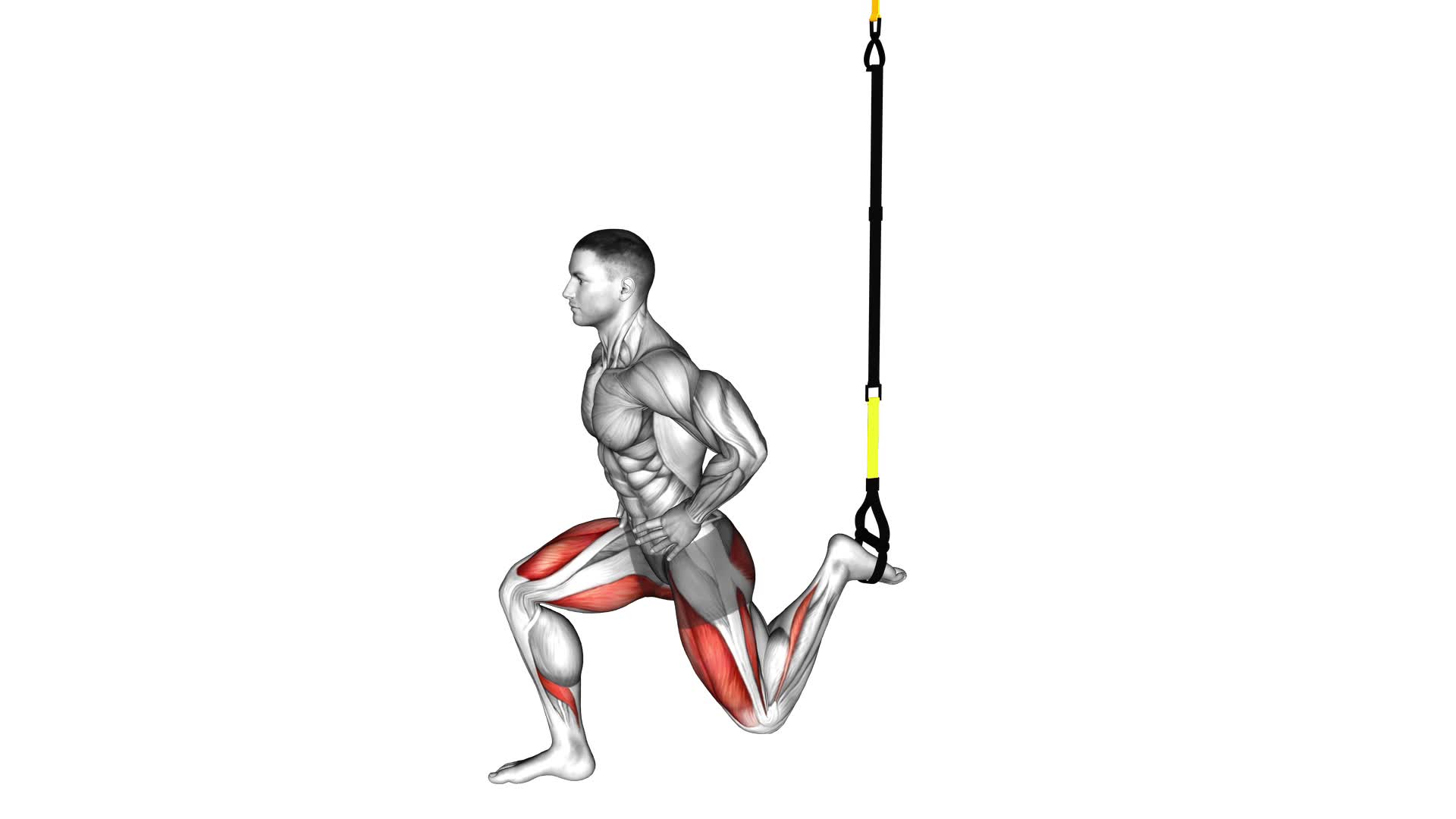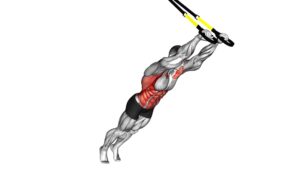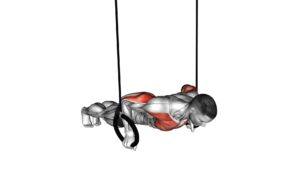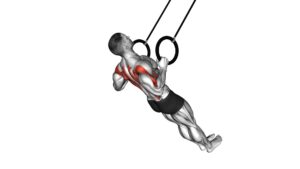Suspended Split Squat – Video Exercise Guide & Tips

In this video exercise guide, you'll learn how to properly perform the suspended split squat.
Watch This Exercise Video
This challenging exercise targets your glutes, quads, and hamstrings while improving your balance and stability.
With the help of a suspension trainer, you'll engage your core and lower body muscles in a unique way.
Follow along the video demonstration and discover tips to perfect your form, avoid common mistakes, and get the most out of this effective workout.
Key Takeaways
- The suspended split squat targets multiple muscle groups, including the glutes, quads, and hamstrings.
- It improves balance, stability, and coordination, making it beneficial for sports performance.
- The exercise builds muscular endurance in the legs, allowing for longer periods of activity without fatigue.
- Variations of the suspended split squat, such as the rear foot elevated split squat and weighted split squat, provide variety and target different muscles for a well-rounded lower body workout.
Benefits of the Suspended Split Squat
You'll experience increased stability and strength in your lower body with the suspended split squat. This exercise is highly beneficial for targeting muscles such as the quadriceps, glutes, and hamstrings. By performing this movement, you can improve your balance and coordination, which can translate into better performance in sports and daily activities. Additionally, the suspended split squat helps to build muscular endurance in your legs, allowing you to perform activities for longer periods without fatigue.
There are several variations of the suspended split squat that you can try to target different muscles and add variety to your workout routine. One variation is the rear foot elevated split squat, where you elevate your rear foot on a bench or box, placing more emphasis on your glutes and hamstrings. Another variation is the weighted split squat, where you hold dumbbells or a barbell to increase the resistance and further challenge your muscles.
Now that you know the benefits and variations of the suspended split squat, let's move on to discussing the equipment and setup for the exercise.
Equipment and Setup for the Exercise
To properly set up for the suspended split squat exercise, you'll need a suspension trainer such as TRX or gymnastic rings. Attach the suspension trainer to a sturdy anchor point, making sure it's secure.
Position yourself facing away from the anchor point, with one foot forward and the other foot suspended behind you.
Necessary Equipment for Setup
To properly set up for the suspended split squat exercise, make sure you have the necessary equipment. Here are the essential items you'll need:
- Suspension Trainer: A suspension trainer is the primary equipment for this exercise. It consists of adjustable straps that can be anchored to a sturdy overhead support, such as a bar or a doorframe.
- Handles: Most suspension trainers come with handles that you can hold onto during the exercise. These handles provide stability and support for your hands.
- Anchoring System: You'll need a secure anchoring system to attach the suspension trainer to. This could be a hook, a bar, or a door anchor.
- Optional Accessories: Some suspension trainers offer additional accessories, such as foot cradles or padding, to enhance your comfort and safety during the exercise.
While suspension trainers offer many benefits, such as improving stability and building strength, if you don't have access to one, you can try alternatives like resistance bands or TRX-style straps. These alternatives can provide a similar workout and help you achieve similar results.
Proper Exercise Positioning
To properly position yourself for the suspended split squat exercise, ensure that you have set up the necessary equipment as discussed in the previous subtopic. Once you have the suspension trainer securely anchored, follow these steps to position yourself correctly.
First, stand facing away from the anchor point and place one foot in the foot cradle, with your toes pointing forward. Position your other foot a comfortable distance behind you, ensuring that both feet are hip-width apart.
Bend your front knee and lower your body toward the ground, keeping your back straight and your core engaged. It's important to maintain proper form throughout the exercise to maximize muscle activation and prevent injury.
Remember that there are variations of the suspended split squat that can target different muscles, so choose the variation that aligns with your fitness goals.
Proper Form and Technique
Ensure that you maintain a stable and balanced position throughout the suspended split squat exercise. Proper form and technique are crucial to maximize the benefits of this exercise and prevent injury. Here are some important tips to keep in mind:
- Keep your chest up: Avoid rounding your back as you lower into the squat position. Maintaining a proud chest helps engage your core and promotes good posture.
- Align your knee and ankle: Make sure your front knee is aligned with your ankle throughout the movement. This helps protect your knee joint and ensures proper muscle activation.
- Engage your glutes and quads: Focus on squeezing your glutes and quads as you push through your front heel to stand back up. This will help target the right muscles and make the exercise more effective.
- Control your descent: Lower yourself down in a slow and controlled manner. Avoid simply dropping down, as this can put excessive strain on your joints.
Modifications and Progressions
Now let's talk about some modifications and progressions you can incorporate into your suspended split squat routine.
If you're a beginner, there are easier variations available that can help you build strength and confidence before advancing to more challenging levels.
On the other hand, if you're an athlete looking to take your training to the next level, there are advanced progressions that can provide a greater challenge and help you continue to improve.
Exploring these modifications can offer a range of benefits, from adjusting the difficulty level to targeting specific muscle groups.
Easier Variations for Beginners
If you're a beginner, try incorporating modifications and progressions into your suspended split squat routine to make it easier. Here are some easier variations and beginner modifications you can try:
- Use a lower suspension point: Lowering the straps will decrease the intensity of the exercise, making it more manageable for beginners.
- Reduce the range of motion: Instead of going into a full split squat position, you can start by only lowering your back knee halfway down. As you progress, you can gradually increase the depth.
- Use a stable surface for support: Holding onto a chair or a countertop can provide extra stability and support, especially if you have difficulty balancing.
- Perform the exercise with bodyweight only: This eliminates the added challenge of using weights, allowing you to focus on mastering the proper form and technique.
Advanced Progression for Athletes
To advance your suspended split squat routine as an athlete, incorporate advanced modifications and training techniques for a more challenging workout.
One modification you can try is adding weight to your routine. This can be done by holding dumbbells or using a weighted vest.
Another modification is to increase the range of motion by elevating your front foot on a step or box. This will engage your muscles in a different way and increase the difficulty of the exercise.
Additionally, you can incorporate plyometric movements into your split squat routine, such as jump lunges or explosive split squats. These movements will help improve your power and explosiveness.
Remember to always maintain proper form and gradually increase the difficulty of your workouts to avoid injury.
Benefits of Modifications
Incorporating modifications and progressions into your suspended split squat routine can provide numerous benefits for athletes. By incorporating modified exercises and variations for different fitness levels, you can tailor your workout to meet your specific needs and goals.
Here are the benefits of incorporating modifications:
- Increased versatility: Modifications allow you to target different muscle groups and challenge your body in new ways.
- Injury prevention: Modified exercises can help you work around injuries or limitations, allowing you to continue training safely.
- Progression: Modifications provide a stepping stone to more advanced exercises, helping you gradually increase your strength and endurance.
- Personalization: With modifications, you can customize your workout to match your fitness level, making it more effective and enjoyable.
Common Mistakes to Avoid
To prevent potential errors and maximize the effectiveness of your suspended split squats, it's crucial that you pay close attention to the following common mistakes.
Proper technique is essential for achieving the desired results while avoiding any unnecessary strain or injury. One common mistake to avoid is improper alignment of the front knee. Make sure that your knee is directly above your ankle and not extending beyond it. This will help maintain stability and prevent any undue stress on the knee joint.
Another mistake isn't engaging the core muscles. Your core plays a crucial role in maintaining balance and stability during the exercise. Remember to activate your core by pulling your belly button in towards your spine.
Additionally, avoid leaning too far forward or backward. Keep your torso upright and aligned with your hips throughout the movement.
Lastly, make sure to maintain proper form throughout the entire exercise. Keep your chest lifted, shoulders relaxed, and gaze forward.
Tips for Getting the Most Out of Your Workout
Maximize the benefits of your suspended split squat workout by incorporating these key tips:
- Use advanced modifications: Once you have mastered the basic suspended split squat, challenge yourself by adding additional resistance or instability. You can do this by holding dumbbells or kettlebells, using a BOSU ball, or performing the exercise on an unstable surface like a balance board or foam pad. These advanced modifications will engage more muscles and enhance the intensity of your workout.
- Maintain proper form: It's crucial to maintain proper form throughout the exercise to prevent injuries and maximize the effectiveness of your workout. Keep your chest up, shoulders back, and core engaged. Make sure your front knee stays in line with your toes and avoid leaning forward or backward. Also, be mindful of your back foot placement and ensure it remains stable throughout the movement.
- Warm up adequately: Before starting your suspended split squat workout, it's essential to warm up properly. This will help increase blood flow to your muscles, improve flexibility, and reduce the risk of injury. Incorporate dynamic stretches and light cardio exercises like jogging or jumping jacks to prepare your body for the workout ahead.
- Listen to your body: Pay attention to any discomfort or pain during your suspended split squat workout. If you experience any pain, modify the exercise or stop altogether. Pushing through pain can lead to injury and hinder your progress. It's better to take it easy and gradually increase the intensity as your strength and endurance improve.
Frequently Asked Questions
How Many Sets and Reps Should I Do When Performing the Suspended Split Squat?
When performing the suspended split squat, it's important to consider the number of sets and reps. To determine this, you should take into account your fitness level and goals. Generally, it's recommended to start with 2-3 sets of 8-12 reps per leg.
However, you can adjust the sets and reps according to your needs. Additionally, there are variations of the suspended split squat that you can incorporate into your routine for added challenge and variety.
Can the Suspended Split Squat Help Improve My Balance and Stability?
The suspended split squat is an effective exercise for improving balance and stability in your workouts. By challenging your core and lower body muscles, it helps to strengthen and stabilize your body during movement.
Incorporating this exercise into your routine can enhance your overall stability and coordination, leading to better performance in other activities.
It's important to focus on proper form and gradually increase the difficulty to continue improving your balance and stability over time.
Is It Necessary to Use a Suspension Trainer for the Suspended Split Squat, or Can I Use Other Equipment?
You don't have to use a suspension trainer for the suspended split squat. While it's commonly used, you can also perform the exercise using other equipment like dumbbells or a barbell.
However, using a suspension trainer offers unique benefits. It challenges your stability and engages your core muscles more effectively.
Plus, it allows for a greater range of motion, helping you get the most out of the exercise.
Are There Any Specific Muscle Groups That the Suspended Split Squat Targets?
The suspended split squat targets multiple muscle groups in your lower body, including your quadriceps, hamstrings, glutes, and calves. By adding suspended split squats to your workout routine, you can strengthen these muscle groups, improve your balance and stability, and increase your overall lower body strength.
There are various variations of the suspended split squat that you can try to target specific muscles and add variety to your workouts.
Can the Suspended Split Squat Be Beneficial for Those With Knee or Hip Issues?
The suspended split squat can be beneficial for those with knee or hip issues. By modifying the exercise, you can reduce the stress on these joints while still targeting the muscles. This can help improve stability and strength in the lower body.
Additionally, for athletes, the suspended split squat can be a great way to enhance performance in sports that require explosive movements and lower body strength.
Conclusion
In conclusion, the suspended split squat is a highly effective exercise for targeting the lower body muscles while improving stability and balance.
By using suspension straps, you can challenge your muscles in new ways and achieve greater results.
Remember to maintain proper form and technique throughout the exercise, and don't forget to modify or progress as needed.
Avoid common mistakes and follow the tips provided to maximize the benefits of this workout.

Author
Years ago, the spark of my life’s passion ignited in my mind the moment I stepped into the local gym for the first time. The inaugural bead of perspiration, the initial endeavor, the very first surge of endorphins, and a sense of pride that washed over me post-workout marked the beginning of my deep-seated interest in strength sports, fitness, and sports nutrition. This very curiosity blossomed rapidly into a profound fascination, propelling me to earn a Master’s degree in Physical Education from the Academy of Physical Education in Krakow, followed by a Sports Manager diploma from the Jagiellonian University. My journey of growth led me to gain more specialized qualifications, such as being a certified personal trainer with a focus on sports dietetics, a lifeguard, and an instructor for wellness and corrective gymnastics. Theoretical knowledge paired seamlessly with practical experience, reinforcing my belief that the transformation of individuals under my guidance was also a reflection of my personal growth. This belief holds true even today. Each day, I strive to push the boundaries and explore new realms. These realms gently elevate me to greater heights. The unique combination of passion for my field and the continuous quest for growth fuels my drive to break new ground.







